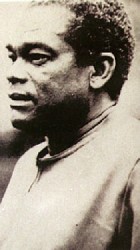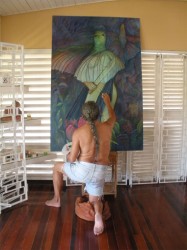The Umana Yana, ironically destroyed by fire during Guyana’s celebration of Amerindian Heritage Month, was a major visible symbol of Amerindian culture in the city. As the nation continues in its observance of that month, there are innumerable interesting examples of the ancient, deep and profound contributions that make up the robust Amerindian factor – the Amerindian presence, in the national culture. An attempt at a recap of these may be a fitting response to the meaning of the loss of that iconic building.
This factor is very well documented, despite huge gaps that are known to exist and the continuing loss due to language death, cultural diffusion, erosion, cultural intrusion and other forms of normal cultural change. Yet some of these factors have assumed a greater and more significant presence in recent years. Added to that are those areas that may be under-documented because of insufficient or unfinished research. To go further, this factor also includes the many inputs into folk life,
The Amerindian presence in national culture and society is considerable, with a significant impact on national identity, in social existence and the broad areas of culture. The Amerindian ethos, cosmic/ world picture, has a firm place and has made a growing contribution to Guyanese culture, literature, art, folklore, mythology; in such areas as theatre and performance traditions, animism and the national patrimony in ethnobotany, folk medicine and artifacts.
A very good example of gains in the balance sheet may be found in the Amerindian presence in Guyanese art. This has definitely advanced from being merely passive subject to a major factor in Guyanese and Caribbean art. Within the holdings of artworks in Guyana are drawings and portraits of Amerindian peoples including single life studies and full-figure portraits, depictions of groups, and scenes of village and community life. Sometimes these were done by or to support the work of anthropologists, appearing as illustrations. These are treated more as archival holdings than as works of art in themselves

For a major part of history there was art with Amerindians and Amerindian life as subject mainly done by expatriates. Eventually in the mid-twentieth century the ‘subject’ began to be treated by national artists, and in the hands of some of the more celebrated, the Amerindian ethos began to become more of an ethnic study and then an important factor in the art.
The most famous of these has been the work of Aubrey Williams, among the most foremost Guyanese artists. He was not Amerindian but went deep into the Amerindian cosmic vision in his paintings, most prominently in the Timehri series murals in the international airport and several canvases based on the motifs found in petroglyphs and ancient Amerindian work. Williams explored the signs, symbols and motifs in abstract paintings to create still the greatest exploration in Amerindian art by a non-Amerindian artist. In his canvases and murals treatment had been very quickly elevated from ‘passive subject’ to important study and the building of something that could be called Amerindian art.
There were others making use of these motifs, particularly two prominent artists who could claim at least part Amerindian ethnicity. Marjorie Broodhagen was one of these, who used aspects of this art in her work, including a large piece of tapestry that hung for several years as a backdrop in the Large Lecture Theatre, now the George Walcott Lecture Theatre at the University of Guyana. More extensive treatment was developed by the other, Stephanie Correia. Primarily a ceramist, Correia began to use the motifs decoratively in ceramic works before more complex explorations in paintings which helped to advance the art from subject to factor.
By far the most telling advance was that great leap forward achieved by Arawak artists in the 1990s. But that had its true genesis with the arrival of George Simon whose meteoric rise took off in the 1980s when he first began to make an impact as a leading national painter. Yet many of his early works were of Amerindian subjects before his research, and his “shamanistic journeys” multiplied these into artistic form. He was to be followed by his brother Oswald Hussain, the sculptor who catapulted Amerindian art into undoubted national notice in the late 1980s with his prize-winning piece in the National Exhibition.
The rise of Amerindian art, one may say, formally announced itself with the exhibition of the ‘Six Lokono Artists’ at the Venezuelan Cultural Centre. This was a group led and taught by Simon in St Cuthbert’s Village and included Hussain as well as Linus Klenkian, and Telford Taylor, all sculptors. The most striking feature of this work was the element of deep spiritualism that has continued to be an important component of the Amerindian factor in Guyanese art today. The Lokono (Arawak) world view has expressed itself in art, contributing not only to subject, but the development of new form in national and Caribbean art. Simon’s work took yet another turn after 2000, as did the sculpture of another ethnic Amerindian artist, Winslow Craig, who after his initial contributions, diversified his preoccupations to become definitely less ethnic, contributing to Amerindian art in other ways.

Of course, what was the source of Aubrey Williams’ inspiration remains an outstanding factor in the nation’s artwork. These are more treated in anthropology and archaeology than in art, and are the famous petroglyphs, known in Guyana as timehri. They include extensive and varied rock paintings, drawings, etchings which are artistic representations as well as signs, symbols and motifs likely of spiritual/religious significance. The best known site for these in Guyana is at Aishalton in the Rupunnuni savannahs which Denis Williams has dated back to 3,000bc. Other sites include Imbaimadai, Shea and Atta, and these are held to be prominent in the national heritage and included in the ‘Wonders of Guyana.’
What constitutes Guyanese art today includes substantial evidence of the Amerindian presence. The same is true of the literature. In this area there has been a similar gain on the balance sheet. The great corpus of oral literature has an overwhelming input of Amerindian beliefs, myths, folk tales, legends, tales and documentation of spirits, animism and folklore. While only some of these can be said to be in active oral circulation among people, it is all very well documented and the published records that contain it represent a substantial volume of Guyanese literature.
These documents are priceless and substantial, containing some of the Amerindian presence in the national literature. They include Walter Roth, An Investigation into the Animism and Folklore of the Guiana Indians; William Hillhouse, Indian Notices; Rev William H Brett, Legends and Myths of the Aboriginal Indians of British Guiana: Barrington Brown, Canoe and Camp Life in British Guiana; Sir Everard im Thurn, Among The Indians of Guiana (short title). Examples of writings in more recent times include Audrey Butt-Colson’s Fr Carey-Elwes and the Alleluiua Indians, and Inter Tribal Trade in the Guiana Highlands as well as two volumes of Amerindian folk tales by Odeen Ishmael and a collection by Dorothy Bland St Aubyn. The holdings of the Amerindian Research Unit at the University of Guyana contribute nearly 40 years of research in both published and unpublished manuscripts contributed by researchers including Butt-Colson, Fr John P Bennett, (including Arawak-English Dictionary with an English Word List), Betty Meggers, Joel Benjamin, Walter Edwards, Desrey Fox, Janette Bulkan (Forte), Anna Benjamin, Laureen Pierre and Jenny Wishart. These cover subjects from linguistics to history, sociology, anthropology and cultural matters, while further volumes at the Walter Roth Museum also include Denis Williams.
Among those elements of folk culture and beliefs that can claim high levels of currency in contemporary consciousness, belief, narratives and conversation is the presence of the kanaima. While some of the anthropologists who have preserved it in the literature are convinced it is little more than the figment of an overindulgent imagination, it is quite differently regarded in the national and popular consciousness. There are narratives, personal testimonies and widespread beliefs. It is true that the general population might be most likely to place the kanaima in the realm of Amerindian mythology and spiritual beliefs. Yet, that does not prevent a pervading sense of fear, which over-rides even the curiosity.
However, Amerindians who relate narratives or talk about it insist that kanaima is neither myth nor spirit, but men who exist and lurk in the shadows of real human society. They are highly trained and enter the realm of the supernatural only because of the specialised orientation and skills they receive and the powers they have acquired. The kanaima can immerse himself in the forest and is capable of becoming things of the forest, particularly its animals – birds, or jaguars (tigers) into which they can transform themselves. No doubt these qualities, to which ventriloquism may be added, allow them to be excellent hunters who can make the sounds of the forest. The main response to kanaima is fear. They are feared because they are hunters of not only animals, but of people. They are assassins who will carry out murderous vendettas on behalf of others, or on their own behalf. They pursue their victims unrelentingly and can kill in gruesome fashion without leaving any outward visible marks of violence since they have the skill to get at and destroy internal organs without causing external injury.
Kanaima is an excellent example of Amerindian belief or phenomenon to present because of his remarkable protean quality. This is characteristic. He moves effortlessly between man and creature of the forest – the forest itself; animal and hunter; human and supernatural; real man and mythology. He belongs to oral literature because of the oral narratives and personal testimonies, but also because of myth, and he has inspired creative writers. There is therefore very profound treatment in some Guyanese fiction, making it a factor in the literature. Presentation of kanaima is only one example of the Amerindian presence in Guyanese literature.
Novelist Jan Carew in Children of the Sun reproduces the myth of Pia and Makonaima, the twins –alter-egos – who chose the opposite paths of benevolence and evil. Pia is interestingly close to the medicine man, the piaiman, while Makonaima resonates with the assassin kanaima. Wilson Harris in The Four Banks of the River of Space draws on this too, for the creation of his character Canaima. Mythology and the workings of the Amerindian psyche are Pauline Melville’s interests in The Ventriloquist’s Tale. Her exploration of the cosmos draws on the hunter, ventriloquism and the oneness with the forest. Even popular novels are well served with such volumes as The Return of the Half-Caste by Lewiz Alyan exhibiting the sensational, the supernatural and the seamy.
It is Amerindian mythology that offers explanations for many things in the Guyana landscape or traditions such as the legend/myth of Amalivaca the demi-god responsible for many industries, useful customs and practices including the tides of the Pomeroon River that are supposed to flow up and downriver at the same or convenient times. Such creation myths also explain the mysteries of the Kaieteur Falls with its flocks of birds and the unseen, mysterious cave behind the sheet of falling water.
Despite grave concerns about cultural and language loss, there remains a powerful Amerindian presence in Guyanese culture. Even the fairly modest indigenous activity in the theatre and performance traditions might require some reassessment after the appearance of many groups and performances from the interior locations at the recent Amerindian Heritage Month celebrations at the Sophia Exhibition site. There is an important Amerindian factor in Guyanese (and Caribbean) art, in Guyanese literature, folklore, mythology and beliefs.






